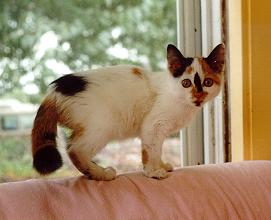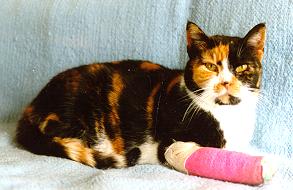
If pics don't appear,right click on mouse,click on show pics.

![]()


In the widely publicized cat killing case involving three young men who broke into a Southeastern Iowa shelter and bludgeoned to death and injured some 29 cats, a verdict was arrived at after a three day trial concluded in Davis County. A rural jury found the three men guilty of breaking and entering the shelter with the intention of harming and killing the cats and guilty of offenses against an animal shelter which constituted two aggravated misdemeanors and one serious misdemeanor. The men were originally charged with two class D felonies and one aggravated misdemeanor. But in a surprise move, defense attorneys Daily and Gardner, during opening remarks to the jury, admitted that the defendants were guilty of intentionally entering the shelter with baseball bats to kill cats. They called it a stupid, teenage mistake. As a result of their admission, most of the state's case which pertained to the actual criminal act of killing and injuring the cats was thrown out. The only issue which remained to be proven in the trial was the actual value of the animal's lives that were either killed or injured, the amount of damages and whether or not this constituted the more than $500 necessary to uphold the felony charge. The defense's position was that a stray cat's life is basically worthless, and that is what they attempted to convince the jury of during the following days of the trial.
The prosecution argued that there were thousands of dollars in veterinary bills sustained by the injured animals, potential adoption fees of $50 per cat that could have been charged by the shelter for the cats that were killed along with all of the care and medical procedures that the cats were given during their lives at Noah's Ark, which included neutering and spaying, vaccinations, blood tests and other medical procedures all of which add to the value of the animal. Testimony was given by two prominent veterinarians, one who had admitted and cared for the cats at the Iowa State University Veterinary Hospital in Ames where some of the more seriously injured cats were admitted following the killings. Another local veterinarian, Dr. Kathy Kline testified about what she had seen when she arrived at the shelter the morning after the break-in. Bodies and blood everywhere, jaws hanging, broken limbs and animals in severe pain and shock. She said she immediately started to try to isolate those animals who might be capable of receiving treatment and who had a chance to recover. Over a dozen animals were found with varying degrees of injuries. She described the scene as like a war zone, with bodies laid out on the lawn in front of the shelter while they rushed to try to save the lives of any who were surviving.
She stated that she gave the recommendation that the injured animals be treated because, she said, they were capable of being saved and of having a chance to live. She talked about her oath as a Dr. which impelled her to help the sick and wounded and to save lives whenever possible. It was argued by the defense that spending the money on these animals to treat their injuries did not equate with their actual market value, and that many people would have just chosen to put the animals down rather than spend that much money on a stray cat. They emphasized that because the veterinary services had been donated to Noah's Ark that this did not constitute an actual expense to the foundation. The state pointed out that in a break-in that had occurred at one of the high schools recently where thousands of dollars of computer equipment was ruined, the local businesses had rushed in to replace that equipment to the school as a donation, but that did not in any way reduce the amount of the damages that constituted the criminal offense which was a felony.
Dr. Graham, a department head at ISU, described the acute pain and fear that the injured animals exhibited when they came into the hospital. She described the cause of all of the injuries to be the same, blunt trauma, which is the medical term for being beaten over the head with an weapon of some kind. Two of the injured animals were adopted by veterinarians at the hospital. One had to have his leg amputated and the other had such a badly shattered jaw that he had to receive nutrition through a tube which was inserted into his side for over a month. Photos were shown of the injured animals both before they were treated and after their recovery. One cat, Pearl, was described as having a serious head concussion and an eye filled with blood. Her brain injury made it difficult for her to walk properly for several weeks and the eye although cleared of the bleeding was lost and she is now blind in one eye.
Because of the defendants admission of guilt to breaking and entering and killing the cats, much of the emotional content of the testimony prepared by the prosecution was not presented. This evidence and testimony would have brought out details about the crime, what was seen, photographs, the extent of the injuries, the dead animals, as well as evidence about the defendants actually killing and skinning their mother's cat the day before. All of this evidence was suppressed and the jury never heard about what really happened that night.
The defense called no witnesses.
In closing arguments, prosecutor, John Morrissey, made an eloquent presentation about all of the ways that the jury should consider an animal's life in this case. He asked them to consider what lawmakers were thinking when they wrote this law as to what its intent was with respect to the value of these animal's lives, because if they were worth a dime a dozen then some 60,000 cats would have had to be killed to bring this charge up to the felony level, and he added, that couldn't be what the legislature had in mind. He also tried to give the jury a sense of what happened that night inside the shelter, the violence, the mayhem that ensued as these cats were helplessly rounded up and beaten to death. He spoke about the four different ways that value for these animals could be assessed and asked them to consider all of the evidence that had been presented. He contested the defense accusation, that he had been pressured into filing a felony charge because of animal protection groups or media. "I filed those charges a week after this incident happened, before anyone even knew about it in the rest of the country." He made a strong case that this was a very serious crime which had caused pain and suffering to both animals and people alike.
After deliberating a little over two hours, the jury returned a verdict of guilty on the three counts charged against the defendants. Those charges were breaking, entering and burglary; offenses against an animal shelter; and other related offenses against an animal shelter. The first two were Class D felony charges punishable by up to 6 years in prison per charge and $7,500 in fines. The jury however, failed to find the value of the dead and injured cats worth more than $500, the amount needed to uphold the felony count and this subsequently dropped the charge down to an aggravated misdemeanor, punishable by only 2 years in prison and up to $5,000 per charge, which makes the men eligible for up to 5 years in prison and $11,000 in fines depending upon what the judge sentences them to. The sentencing hearing is scheduled for December 12th at which time the judge will hear expert testimony from Rick Swain of the Humane Society of the United States about the link between cruelty to animals and subsequent violence and crimes to humans; the victims, David and Laura Sykes will also have the opportunity to say what they would like to see happen and to give some testimony about their experience. A separate restitution hearing has been scheduled to occur after the sentencing at which time a victim impact statement will be heard. At that time, all of the losses both to the shelter and to the victims will be presented as evidence to the judge with the request that the convicted men pay back monies spent for injuries to the animals, damage to the shelter, and any personal damages that the victims sustained as a result of the incident.
Comments made to the press by the jury indicated that they attributed a value of only $31.25 to the cats who had been killed. One of the jurors made comments to the press after the trial that "It was a stupid mistake, but we've all killed cats at one time or another when we were younger, you know, teased them, tormented them or kicked them around. We (the jury) didn't ever think the cats were worth more than $500, but we took the breaking and entering part pretty seriously." In a live interview with one of the local TV stations, one of the defendants uncles asked the news correspondent if she had ever killed a cat. She looked down and said "No" and he said, "Well I have," and then proceeded to describe in a story laced with profanities how he killed cats by kicking them around until they were dead. The day before, relatives of the defendants had been threatening media in the hallway outside of the courtroom.
Sentencing of the two convicted men is set for December 12th at which time the judge will decide what their actual punishment will be.
December 19th, 1997
The Judge, Daniel Wilson, issued a sentence to the two convicted defendants in the Noah’s Ark cat killing case on Friday, December 19th at the conclusion of a three-hour hearing. At approximately 5pm the two men were sentenced by the Judge to the following punishment: they received a 2 year suspended sentence which was then reduced to 23 days in the County jail plus credit for time they had already spent in jail previously in March when they were first arrested; $2,500 in fines; and entrance into the Youthful Offender program which is a 4 year program for first time offenders who do not have a previous criminal record. In addition he gave them 3 years of probation. The maximum jail time they were eligible for under the 3 misdemeanor counts that they were convicted of was 5 years. The maximum fine that they could have received was $11,500.
The two men had been convicted of breaking and entering into an animal facility, offenses against an animal facility with intent to harm animals; and other related offenses which constituted 3 offenses, two aggravated misdemeanors and one serious misdemeanor which was reduced from two felonies to two misdemeanors when the jury trying the case failed to find sufficient value, equaling the $500 threshold needed to uphold a felony count, attributable to the loss and injury of the 25 cats who were beaten to death and injured last March at the Noah’s Ark animal shelter.
Testimony at the hearing from the state was heard by Dr. Randall Lockwood from the Humane Society of the United States who is a research psychologist who has studied extensively the link between animal cruelty and the propensity towards violence to humans. He has a book coming out shortly which documents much of this information and research. He was questioned by the prosecution about this subject and about the likelihood of animal abusers moving on to commit more serious violent crimes. Dr. Lockwood substantiated this claim and talked about the various psychological tests that showed indications of psychopathic behavior.
Sergeant Joe Smutz also testified about what he discovered when he investigated the crime scene last March and showed photos of the dead cats lying in blood on the floors of the shelter and he described some of the damage that he observed from the crime. He also showed the skin of a dead black and white cat that that had been shot, skinned and paraded around by the two men on a stick a few days before the actual cat killing at Noah’s Ark took place. The cat belonged to Lamansky’s mother and lived on their farm. It had been killed as a practical joke because it looked similar to cat belonging to Meyer’s brother-in-law. Charges had never been filed against Lamansky or Meyers for this offense.
David Sykes, Director of the Noah’s Ark Animal Foundation also testified and gave an impassioned presentation of his victim impact statement to the Court, a transcript of which follows. In his statement Sykes elaborated upon his experience the morning of March 8th when he walked into the shelter and discovered what he described as "a scene of mass murder, death and violence, that nothing could have prepared him for.’ He told about what he went through that day as he came upon the beaten and dead bodies of feline friends that he had protected and cared for through the years and in the painful days and nights that followed. His story was filled with tremendous emotion of heartbreak and loss. He told of his fear of these men who had committed this horrible act of their lack of remorse for what they had done. He described the response that had resulted from the extensive media coverage and the thousands of calls and letters that the shelter had received over the months from people all over the country and even in different parts of the world who were shocked, outraged and horrified over the brutal beatings of the cats at Noah’s Ark. And he told about how this crime had cast such an unfavorable light upon the whole state of Iowa and how the entire nation was watching this proceeding and waiting to see what would happen to these men. He issued a plea for justice, a request for strict punishment and maximum sentencing of the two convicted men so that not only could his shelter and the community be protected from further threat, but that the whole state could begin to repair its battered image which has been depicted in the media as being backwards, barbaric and tolerant of vicious acts of cruelty towards animals.
Maggie Moss, Attorney for David & Laura Sykes then spoke for Laura because, she said, Laura had undergone psychological counseling because of the experience, had suffered extreme emotional pain, and did not wish to address the Court in front of the two convicted defendants. She spoke about how the issues in this case had never been adequately addressed. How the defense lawyers had succeeded in distorting the focus of the case away from the vicious and terrible acts of violence committed by Lamansky and Meyers and had instead focused on the media coverage, and other subsidiary issues. She said "the problem is these men just don’t get it." The defense lawyers called one witness, Les Gruel, to the stand. He was the person in charge of the Department of Corrections in Ottumwa and he helped conduct and evaluate the pre-sentence investigation. He spoke of the fact that these two men had employment, one of them was going to school and that they appeared to be leading productive lives. His recommendation was that they be admitted into the Youthful Offender program in lieu of going to prison. He cited that they had no previous record, had been interviewed by a social worker and passed their psychological evaluation, and had support from their families. The absence of a previous criminal record was also a pre-requisite for entrance into the program. During cross-examination, he was asked about the men’s psychological testing and what the results of those tests had been. Gruel said that a psychologist had not evaluated the two men yet, but that people with abnormal psychological results or a history of violence were not eligible for admittance into this program. He was then asked why these men had not had received actual evaluations performed by a qualified psychologist and his answer was that the psychologists had been unavailable for the past several months for appointment. Morrissey asked him if he had ever had anyone in the program who had committed a crime like this one which was so brutal and violent. Initially he said yes he had but not with so much media attention. But upon further questioning he said that he had not ever admitted anyone into the program with a record of a crime of this much violence. Gruel mentioned that one of the criteria for admittance into the program was that a person did not have a history of violence. Morrissey asked if some of these things, like the skinning of his mother’s cat, did not constitute other acts of violence depicting a violent personality. Gruel said this was not considered in the evaluation and that they simply went on the basis of no previous criminal record.
The Judge then proceeded to issue the sentence at approximately 5:15 PM. He spoke primarily to Lamansky and Meyers as he remunerated their crime and the viciousness of it. He said "and it is ironic that the animals you killed also were in an environment for their protection." He also cited that it was commendable that they had jobs and went to school and he had considered all of that as well. He said that according to the law (he cited the code number) he was prohibited from being influenced in his decision by letters or other outside opinions. (Earlier in the proceeding in response to objections from the defense attorneys about all of the letters that were being generated by the internet, he had told them that he had given all of the letters that had come in to the Clerk of the Court, indicating that they had not influenced his decision and that he had not read them.
The sentence that he gave them was a two year concurrent sentence (four years) to be served in the state penitentiary, however he then suspended this sentence and gave them 3 years in the Youthful Offender’s program with 23 days in the County jail and 3 years probation. He gave them credit for the time they had spent initially in jail when they were first charged back in March, and this then amounted to 11 days for Meyers and 18 days for Lamansky. He also fined them $1,000 for the two aggravated misdemeanors and $500 for the one serious misdemeanor totaling fines of $2,500. Defense lawyers asked that the bail money they had paid in March be subtracted from this amount, but the Judge denied this. The two men were handcuffed and escorted by armed deputies from the courtroom back to the Jefferson County jail. Newspapers later reported the headlines: "23 days for 23 cats" Shelter Director says "It’s a slap on the wrist."

![]()


| Site Map Purrfect Pets~Marvelous Meows |
 Noahs Ark Animal Foundation
Noahs Ark Animal Foundation